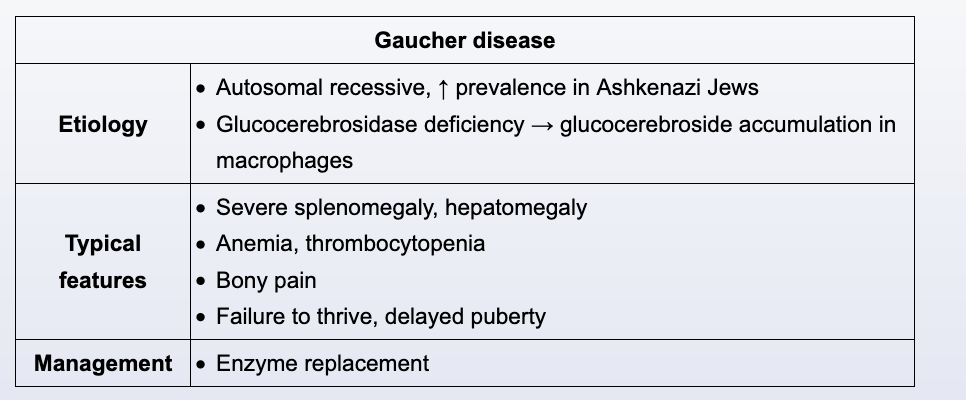lysosomal storage disorders

This patient had a significant transverse tibial shaft fracture following relatively minor trauma (eg, tripping), consistent with a pathologic fracture. Given his "growing pains," splenomegaly, anemia, and thrombocytopenia, this presentation raises suspicion for Gaucher disease (GD).
GD is an autosomal recessive lysosomal storage disorder due to glucocerebrosidase deficiency. Glycolipids (eg, glucocerebrosides) accumulate within the lysosomes of macrophages, which infiltrate and disrupt various organs:
- Bone marrow infiltration results in anemia and thrombocytopenia.
- Splenomegaly is severe and typically more prominent than hepatomegaly.
- Skeletal involvement causes bony pain, which can present as pain crises at night (often misconstrued as growing pains).
- Low bone density (eg, osteopenia) predisposes to pathologic fractures following minimal trauma.
- Other common features include failure to thrive and delayed puberty.
Type 1 GD is the most common form and, due to varying severities, can present at any time from early childhood to late adulthood. Diagnosis is made by mutation analysis or by demonstrating decreased glucocerebrosidase levels in leukocytes. Treatment with enzyme replacement therapy can slow disease progression and prevent complications such as osteonecrosis.
A 12-year-old boy is brought to the emergency department with right leg pain that began immediately after he tripped during a soccer game about an hour ago. Ice was applied on the field with no relief, and the patient has been unable to walk. Since early childhood, he has experienced "growing pains" in his legs that have frequently awakened him at night. The current discomfort, however, is significantly more severe and localized. The patient has been healthy and takes no medications. He is active and enjoys playing multiple sports. On examination, he is awake and alert but in moderate pain. Cardiopulmonary examination is normal. The abdomen is soft and nontender, and the spleen is palpable 5 cm below the left costal margin. Laboratory studies show a hemoglobin level of 10.5 g/dL and platelet count of 95,000/mm3. Point tenderness is present over the right tibia proximally, and the patient is unable to bear weight on the affected leg. X-ray reveals a transverse proximal right tibial diaphyseal fracture. A metabolic disturbance of which of the following could account for this patient's findings?